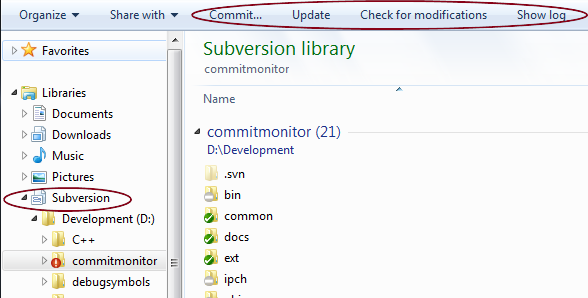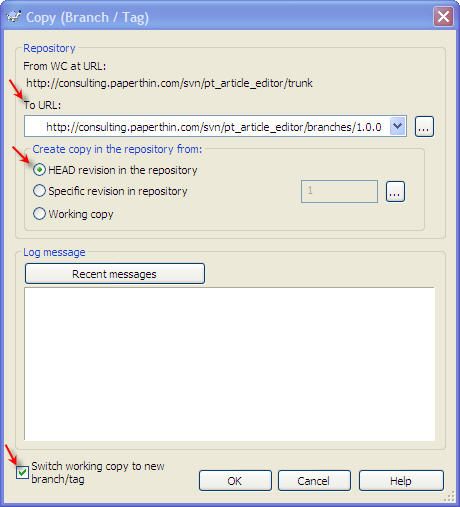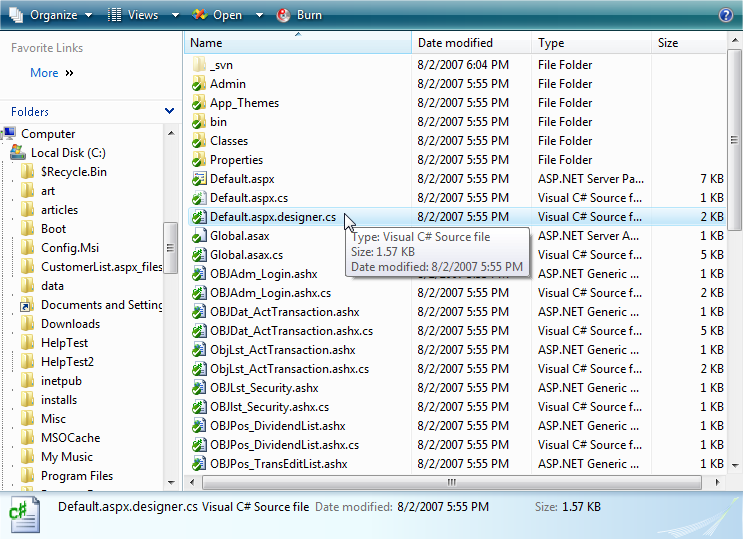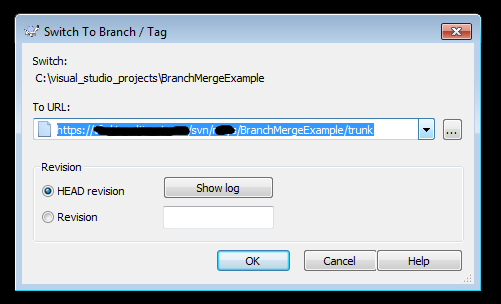
- #TORTOISESVN DOES NOT COPY LOG WHEN BRANCH UPDATE#
- #TORTOISESVN DOES NOT COPY LOG WHEN BRANCH MANUAL#
- #TORTOISESVN DOES NOT COPY LOG WHEN BRANCH WINDOWS#
In fact, this feature is the basis of how commits work in Subversion: each revision is a “cheap copy” of the previous revision, with a few items lazily changed within. It doesn't matter how large the directory is-it takes a very tiny, constant amount of time to make a copy of it. This is why you'll often hear Subversion users talk about “cheap copies”. That is, if you commit a change to one file within the copied directory, then only that file changes-the rest of the files continue to exist as links to the original files in the original directory. From there, the copy is said to be “lazy”.

If you're a Unix user, this is the same concept as a hard-link. Instead, it creates a new directory entry that points to an existing tree. When you copy a directory, you don't need to worry about the repository growing huge-Subversion doesn't actually duplicate any data.

Subversion's repository has a special design.
#TORTOISESVN DOES NOT COPY LOG WHEN BRANCH MANUAL#
No matter what the initial check out was for that local folder.SVN "cheap copies and branches" is explained in the manual ( ). Past exectution of command, every further commits on the working copy will occur on the distant repository folder which's been switched to, which's been targeted. switch only sync differences between local and remote, hence avoiding to do a whole check out of a solution. But none would be "implicitly selected".Īs Paul Sasik quotes : switch would allow, for instance, to have only one working copy of say, the trunk, and then, merging that local working copy with a targeted branch or tag from the remote repository. The truth is : there is no such thing as a current working copy ! There are just many local working copies : one for the trunk, one for a branch another for a tag and so on. Like I'm currently working on trunk, then I'm working on a branch B, hence "switching" from a working copy to another. There might be a misconception about svn switch :Īt first I thought that the existence of a switch command would imply that there were a "current" or a "selected" working copy for the proper functioning of SVN. Trunk checkout in another folder, then TortoiseSVN → Switch.
#TORTOISESVN DOES NOT COPY LOG WHEN BRANCH WINDOWS#
If you want to work on trunk and branch, but don't want the expense ofĪ fresh checkout, you can use Windows Explorer to make a copy of your Switching, or revert your working copy to an already-committed Not want this to happen then you must either commit the changes before Yet been committed will be merged when you do the Switch. Any changes you have made to your working copy which have not
#TORTOISESVN DOES NOT COPY LOG WHEN BRANCH UPDATE#
Switch works just like Update in that it never discards your localĬhanges. Select the Head Revision radio button and click on OK. In the next dialog enter the URL of the branch you just created. Again select the top level folder of your project and use Switch your current working copy to the newly created copy in the You can check out to any location on your local disk and you canĬreate as many working copies from your repository as you like. TortoiseSVN → Checkout to make a fresh checkout in an empty folder. To be able to work with your freshly generated branch or tag you have

Good for the network load, good for your patience. While a checkout downloadsĮverything from the desired branch in the repository to your workingĭirectory, TortoiseSVN → Switch.

I think that in your case it would be simpler to just check out the branch to a different folder since you're just doing review and it may be the most straightforward way to proceed regardless. The difference between checkout and switch might be adding to the confusion.


 0 kommentar(er)
0 kommentar(er)
